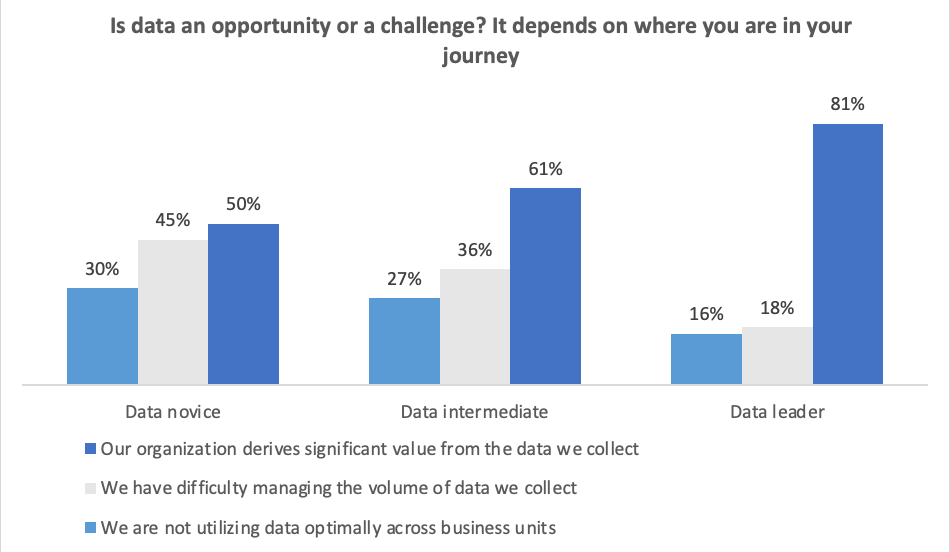How to get actionable insights from your data

“When you peel back business issues, more times than not, you will find that the root cause is directly tied to data problems,” says Matthew Minetola, CIO at Elastic®. In today's world, all companies, new and old, are awash in data from multiple sources — stored in multiple systems, versions, and formats — and it’s getting worse all the time.
Companies see exponential growth in the amount of data they gather, store, analyze, and use. Executives report that data volume grew by 36% over the past three years, and they expect it to swell by 61% over the next three years, according to a survey conducted by Elastic and ThoughtLab in September–October 2022. The survey, which polled 800 executives in eight industry sectors across eight countries, showed that this avalanche of data poses myriad challenges for organizations.
As their businesses evolved over the years, companies accumulated huge amounts of data hobbled away in different systems and departments across their enterprises. Unfortunately, many of these firms fail to gain actionable insights from this data, some of which they don’t even know exists. Meanwhile, businesses continue to pile on new data from new digital sources, such as cybersecurity monitoring systems, the Internet of Things, and biometrics.
More than a third of executives surveyed say they have difficulty managing the volume of data they collect. They struggle to gain access to data in different siloed storage systems, format it in a usable and consistent way, ensure its quality and security, and integrate it from multiple sources into a single platform.
Once they have their data in the needed form, organizations also face problems putting it to work. More than 4 in 10 respondents say that using data to personalize the customer experience is a major challenge, and a quarter admit they are not using data optimally across business units.
Capitalizing on data
In a data-driven world, the winners are those enterprises that view data as an opportunity, rather than a problem, harnessing it to drive their growth and performance. The losers are those that buckle under the weight of an ever-growing data mountain.
Of the 800 companies surveyed, 184 were identified as “data leaders” — firms that had made the greatest progress in creating the organization, processes, and data platform for managing the upside and downside of data. Over 8 out of 10 leaders report that they already derive significant value from data, and relatively few find it difficult to manage the higher volume of data or fail to optimize their use of data across business units.

The research shows that organizations that harness data not only see jumps in revenue, profits, and cost efficiencies, but they also report improvements in innovation, teamwork, and decision-making. Over half of the enterprises surveyed already see higher revenue and profitability, and that number will grow to two-thirds or more over the next two years.
To gain these benefits, enterprises must become fully data-enabled. The Elastic and ThoughtLab research found that data leaders do five things better than other firms:
Leaders install a unified, modern data and IT platform that enables their organization to efficiently observe, search, secure, analyze, and operationalize data. For example, Danone, a French food conglomerate, built a data lake on the cloud, with components to provide secure mobile access, support customer management, and help employees do their own analysis and prepare reports. “We want to nurture an entrepreneurial mindset and enable staff to use data as an asset,” according to Bilal Alani, the head of IT and data.
Leaders harness search-powered solutions to get ahead of data by extracting value from external and internal data in real time. AT&T Services uses search technologies to group and understand its huge volume of log data, running data visualization tools to help analyze it. Ram Kumar, IT director, says the bottom line is serving customers and fixing their problems. “Finding the right set of data, searching it, logging it, organizing it, aggregating it, correlating it, and keeping it together, is the key.”
Leaders embed the latest digital technologies into data solutions, such as cloud, AI, automation, mobile apps, and cybersecurity, which help make their data work harder, faster, more safely, and at scale. Putnam Investments, for example, has built its own machine learning models to look at huge data sets in different investment segments. “Machine learning tools enable us to analyze data 10 times faster than we were able to do before,” notes Sumedh Mehta, the firm’s CIO.
Leaders use data to supercharge all aspects of the business, from building products, services, and business models, to improving operations, experiences, and decision-making. Self-service trading platform eToro runs on data, from streaming quotes to customer portfolios to transactional and historical data. Says Israel Kalush, vice president of engineering and technology, “We use every insight we have on our customers, what they’re looking for, what they're doing, how they're using our platform, to optimize the experience we're providing.”
Leaders build a data-driven organization and culture, along with installing the talent and policies needed to deliver results successfully and responsibly. Invesco, an investment management company, hired a chief data officer and built an enterprise data office, then installed data offices in each of the business areas to work together as a community, according to CTO Donie Lochan. “We have a much more streamlined alignment between the tech and business teams, and we go faster as an organization,” he says.
Find out more about how leaders are harnessing the power of data to drive growth and increase revenue. Download the report.

